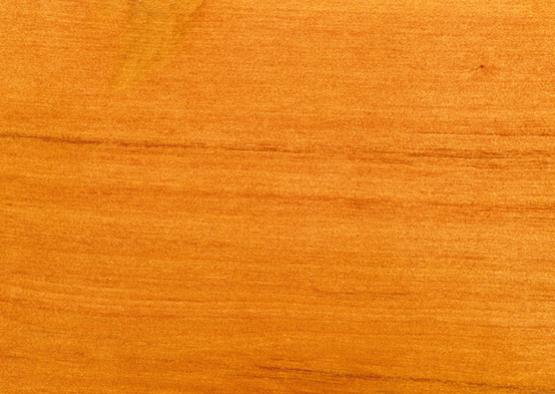Coachwood is a primarily decorative hardwood timber sourced from coastal rainforests of New South Wales and Queensland.
Scented Satinwood, Tarwood
Ceratopetalum apetalum

Coachwood is a medium-sized hardwood tree found in the coastal rainforests of northern New South Wales and southern Queensland. The true wood of this species – not always clearly distinct from the sapwood – is a pale pink to pinkish-brown colour. The grain is usually straight, with a fine and even texture. Due to banding of soft tissue (parenchyma) in the wood, the timber is often highly figured on back-sawn surfaces. The wood has a distinctive ‘caramel’ odour – hence one of the species’ common names is Scented Satinwood.
Coachwood is only moderately durable, with a life expectancy of between five and seven years for in-ground and aboveground applications, respectively. Coachwood is not resistant to termites, and its untreated sapwood is susceptible to lyctid borer attack. The sapwood (but not heartwood) of this species is readily impregnated with preservatives.
Coachwood is moderately hard (rated 4 on a 6-class scale) in relation to indentation and ease of working with hand tools. The timber machines well to a smooth surface. It accepts standard fixings and fastenings but tends to split when nailing (pre-drilling is recommended). Coachwood glues well and readily accepts most coatings. Coachwood responds better to water- and spirit-based stains, than to oil-based equivalents.
Uses of coachwood timber are predominantly decorative, although it is used as a flooring material and for spars and masts in boatbuilding. Common applications include turnery, carving, interior fittings, sporting goods, furniture and cabinetwork. Coachwood is also found as a decorative veneer. Courtroom number three of the High Court of Australia is furnished with coachwood timber.
Shrinkage
| Very Low | Low | Medium | High | Very High | |
|---|---|---|---|---|---|

|

|

|
|||
Tangential : |
8.10%
|
||||
Radial : |
4.00%
|
||||
Unit Movement Tangential: |
0.34%
|
||||
Unit Movement Radial: |
0.24%
|
Strength Group

Very High |
High |
Reasonably High |
Medium High |
Medium |
Reasonably Low |
Low |
Very Low |
||
Unseasoned: |
S1 |
S2 |
S3 |
S4 |
S5 |
S6 |
S7 |
S8 |
|
|---|---|---|---|---|---|---|---|---|---|
 |
|||||||||
Seasoned: |
SD1 |
SD2 |
SD3 |
SD4 |
SD5 |
SD6 |
SD7 |
SD8 |
|
 |
Stress Grade

| Structural No. 1 |
Structural No. 2 |
Structural No. 3 |
Structural No. 4 |
Structural No. 5 |
|
Unseasoned: |
F11 |
F8 |
F7 |
F5 |
F4 |
Seasoned: |
F22 |
F17 |
F14 |
F11 |
F8 |
Density per Standard

Seasoned: |
602kg/m3
|
|---|---|
Unseasoned: |
930kg/m3
|
Joint Group

Very High |
High |
Reasonably High |
Medium |
Low |
Very Low |
|
Unseasoned: |
J1 |
J2 |
J3 |
J4 |
J5 |
J6 |
|---|---|---|---|---|---|---|
 |
||||||
Seasoned: |
JD1 |
JD2 |
JD3 |
JD4 |
JD5 |
JD6 |
 |
Colour

| White, yellow, pale straw to light brown | Pink to pink brown | Light to dark red | Brown, chocolate, mottled or streaky | |
 |
||||
Mechanical Properties
Modulus of Rupture - Unseasoned: |
62
|
|---|---|
Modulus of Rupture - Seasoned: |
101
|
Modulus of Elasticity - Unseasoned: |
12
|
Modulus of Elasticity - Seasoned: |
15
|
Maximum Crushing Strength - Unseasoned:  |
27
|
Maximum Crushing Strength - Seasoned: |
50
|
Impact - Unseasoned: |
11
|
Impact - Seasoned: |
13
|
Toughness - Unseasoned: |
Low - up to 15 Nm
|
Toughness - Seasoned: |
Medium - 15 - 24 Nm
|
Hardness - Unseasoned: |
3.1
|
Hardness - Seasoned: |
4.8
|
Durability
| Low | Moderate | Reasonably High | High | |
| (0 - 5 yrs) | (5 - 15 yrs) | (15 - 25 yrs) | (more than 25 yrs) | |
In-Ground: |
 |
|||
| (0 - 7 yrs) | (7 - 15 yrs) | (15 - 40 yrs) | (More than 40 yrs) | |
Above ground: |
||||
| (0 - 20 yrs, usually < 5) | (21 - 40 yrs) | (41 - 64 yrs) | (More than 60 yrs) | |
Marine Borer Resistance: |
 |
Lyctid Borer Susceptibility: |
Not Susceptible |
|---|---|
Lyctid Borer Susceptibility - Other: |
|
Termite Resistance: |
Not Resistant
|
Fire Properties
| 1 - non-combustible | 2 - reasonably non-combustible | 3 - slightly combustible | 4 - combustible | |
Fire Properties Group |
Group Number - Other: |
3 if used on MDF or particleboard ≥12mm; veneer thickness 0.6-0.85mm
|
|---|---|
Average Specific Extinction Area: |
<250
|
Bushfire Resistance: |
Not Tested
|
Coachwood’s heartwood, not always distinguishable from the sapwood, is pale pink to pinkish-brown in colour. Grain is usually straight with a fine and even texture. Coachwood is often highly figured on back-sawn (tangential) surfaces due to banding of soft tissue (parenchyma). The wood has a distinctive, not unpleasant, ‘caramel’ odour.
Coachwood is commonly used as a joinery and cabinetmaking timber, and is also used for turning, skirting, mouldings and internal panelling. It is found in plywood, as a decorative veneer, in gunstocks, shoe heels and sporting goods. Coachwood is also used in carriage construction and boatbuilding (spars and masts).
Coachwood is a firm timber but not difficult to work. It turns well except for a tendency to bruise on the end grain. It glues satisfactorily. Coachwood is unsuitable for steam bending and tends to split in nailing (pre-drilling is recommended). It takes water and spirit stains much better than oil stains.


